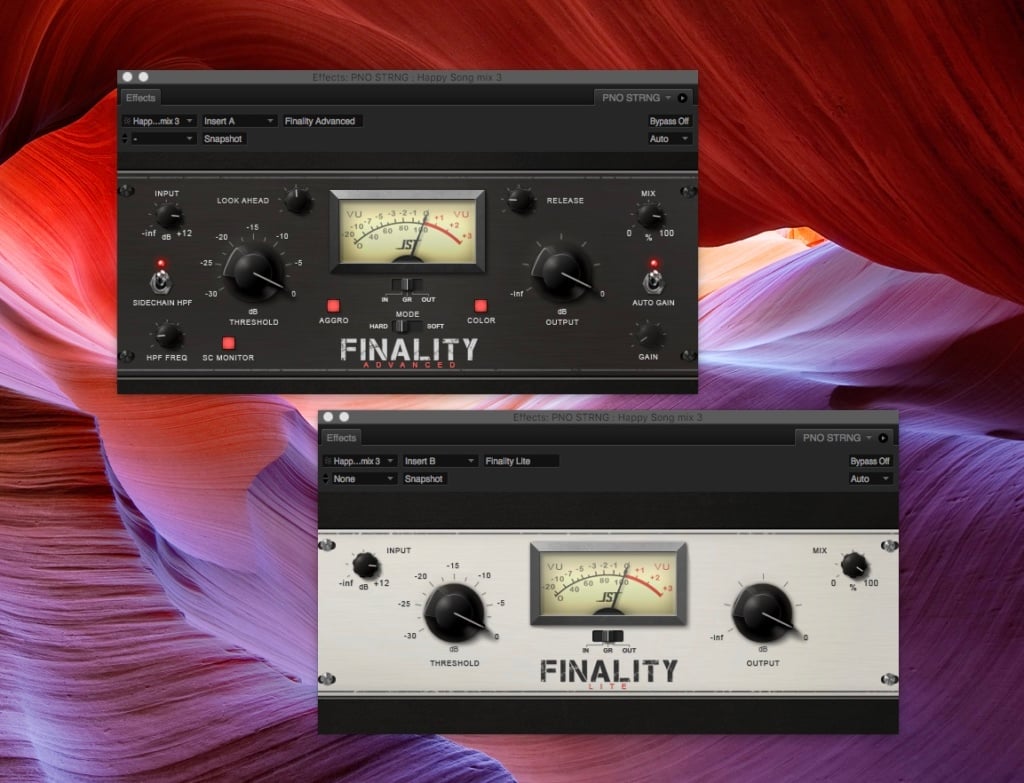The Finality Limiter Plug-In from JST (Joey Sturgis Tones) features tons of tonal variety and is very easy to use.
I do a LOT of mixing for self-recording artists and the most common problem I see with their tracks is excessive dynamics, as in too much level variation. That is, the peaks tend to be too wild and there’s not enough average-volume consistency. There new Finality plug-in from JST (Joey Sturgis Tones) can do wonders for such issues and no, it’s not a compressor, but a limiter…and you need it!
WHAT IS A LIMITER?
A limiter is simply a compressor with a really high ratio (generally 10:1 and above) and they offer the ability to stop peaks from ever going beyond zero dB and distorting “in the red” with “brickwall” (no overshoot) operation. Yes, that can get pretty ugly if you’re not careful, but that’s where Finality shines. There’s a Soft mode that aims to be inaudible and neutral, there’s a Hard mode that is more grabby and dramatic, an Aggro mode that benefits snappy/transient sources like drums and finally a Color switch that introduces a little growl and grind with some saturation (today’s sup du jour).
Such varied tonality choices are unusual and desirable in the world of limiters, but the rest of the Finality package keeps up the pace with thoroughly modern options. One big plus is Lookahead operation, where Finality inspects the audio signal milliseconds prior to applying limiting; such advance notice makes for smoother, distortion-free behavior. Another plus is the Sidechain filter. Simply put, this filter allows Finality to disregard low bass frequencies when inspecting the audio signal, preventing the pumping and shrinking that might happen otherwise. For advanced users there’s even a parallel-processing mode with the Mix control that allows the blending of limited and un-limited signals … a secret weapon for many mixing and mastering engineers.

JST Finality screenshot
Joey Sturgis Tones Finality Features & Drawbacks
Don’t let the complexity fool you; such options increase Finality’s usefulness beyond typical limiters in a big way and the ease of use is still … easy. Knobs can be turned quickly, or switched to a slow mode and numerical values can be directly entered (my favorite method). You can set the output level manually, or allow Gain to be compensated automatically.
One drawback (the only one?) is the metering, where the single large VU meter doesn’t show the details of light attenuation. Some single-digit LEDs or a sensitive meter-mode would be useful.
Such a feature set allows Finality to be used on drums (naturally), vocals (especially rock vox where a little color/saturation is often welcome), bass (especially with a compressor placed before Finality), whole mixes and even mastering.
No one’s audio can exceed the digital maximum of 0 dBFS, but we are expected to knock on that door with regularity (if we expect our mixes and masters to keep up to today’s loud and saturated standards). With Finality applied carefully to tracks, busses, mixes and masters you can reach those elusive standards along with numerous artistic tonal options to further personalize your sound.
PROS:
fantastic dynamic control, tons of tonal variety, easy to use.
CONS:
limited metering options.
PRICE:
$79
ABOUT THE AUTHOR
Rob Tavaglione is the owner/engineer for Catalyst Recording in Charlotte NC. He has been in countless bands and has gigged from the Southeast USA to New York, to Los Angeles. He is a songwriter, singer, backup vocalist and multi-instrumentalist including guitar, bass, keyboards, programming and percussion.
What do you think of our JST Finality review? Sound off in the comments below or drop a line on the Performer Magazine Facebook page or on Twitter @Performermag.
